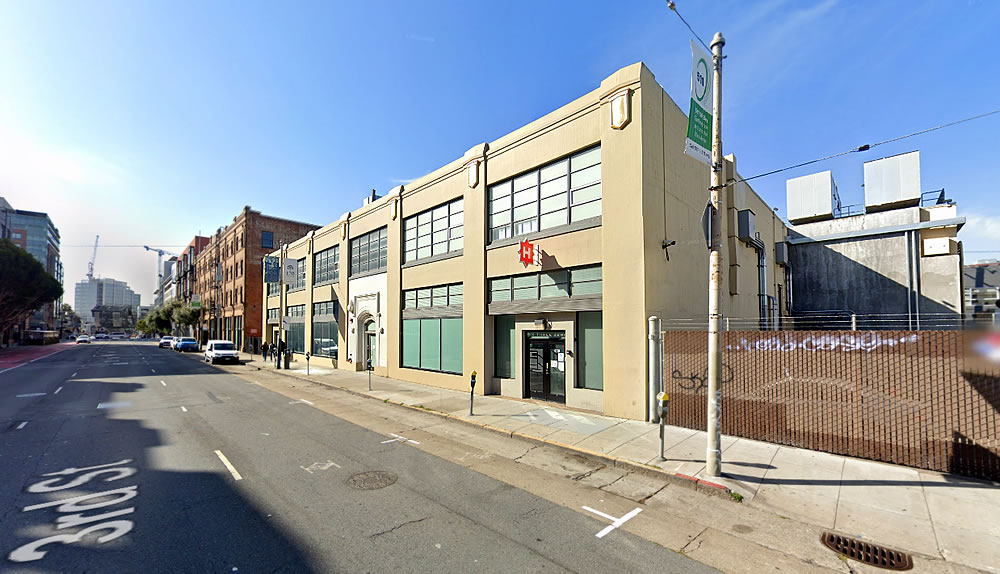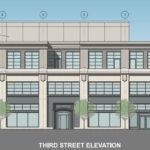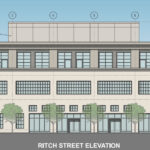Built in 1924 and acquired for $9.25 million in March of 2006, plans to expand and convert the Colgate Building at 620 3rd Street, which also fronts Rich, is a contributor to the historic Clyde and Crooks Warehouses District and is currently being used as a data center, have been drawn.
As rendered by Heller Manus and below, a 16,300-square-foot third story addition is slated to be constructed atop the existing 41,200-square-foot building.
And as proposed, the expanded building would then be converted into…49,990 square feet of open floor plan office space, with 2,600 square feet of ground floor retail along 3rd Street and off-street parking for 10 bikes, along with two showers and a locker room for those who biked to work.



“[…] 49,990 square feet of open floor plan office space, with 2,600 square feet of ground floor retail […]”
Is the developer holding the business-cycle chart upside-down?
Suicide pact?
Out-of-season April Fool’s joke?
Hallucinogenically-induced dissociative state?
“Don’t think I can go bankrupt? Hold my beer!”
Psst, buddy, you might want to research how much vacant office and retail space there is all over FiDi and SOMA, not to mention how much more empty space will be dumped as the big tech “warehousing” leases expire.
wtf?
But it has off-street parking for 10 bikes…
This is a small office development that would be suited for one or more small businesses. And, if it proceeds, by the time it gets approved and built, this would likely occur in a timeframe of four years out when the market will will look different (work from home is here to stay but that is not anywhere near 100% of the workforce).
There *is* a huge glut of vacant office space in office towers and larger SOMA tech spaces, but this is not a big SOMA tech development or a flashy downtown office tower. Developers are not planning new office towers or large SOMA offices anymore, but a business that would rent a small space like this is not the sort of business that would rent in a flashy corporate office tower or a big SOMA warehouse conversion. It could even be a good space for some non-profits, depending on what they do.
You are missing the point that I think two beers is trying to make here. A business that would rent a small space like this is not the sort of business that would rent in a flashy corporate office tower or a big SOMA warehouse conversion primarily because they can’t afford the current asking rents. It’s as simple as that.
If the rents in the flashy corporate office towers or a big SOMA warehouse conversions that are currently sitting vacant or unused glutting up the sublease market had their rents reduced to the market clearing price, then there would be no need for this “small office development” and in fact those businesses could go on leasing currently underutilized properties for years, if the rents were affordable to those businesses, before the glut is cleared.
If your only defense of this project is that it will, at some point in the future, offer affordable rents to the sort of businesses that only can currently occupy small offices, then the simple and direct solution would be to encourage the owners of the currently surplus office property lower their asking rents to make vacant offices affordable to those who currently are seeking offices and can’t afford asking rents at flashy office towers and larger SOMA tech spaces.
You are oversimplifying things. First, you assume the current office vacancy rate will stop exist 4-5 years in the future when this new project would assumedly become available. Second, you don’t seem to know just *how* expensive rents in corporate tower and large SOMA tech offices remain.
The average rent is still about $90 per square foot in SOMA and $80 in the financial district. Hypothetically, let’s say the rents came down by 50%. That would still be a very high rent for most small businesses (and certainly non-profits) to pay—well above even Class A office space in other more affordable cities like Indianapolis, Tampa, Charlotte, etc.
Third, this is private property, and assumedly the owner wants to make money off on it. Unless they are a first time inexperienced developer, they did they’d due diligence and feel their investment meets their risk expectations. None of us have a crystal ball, but what others wish to do with their own money is purely their concern.
I absolutely concede that I am assuming the current office vacancy rate will only improve marginally –if it doesn’t worsen on an absolute basis – over the 4-5 years in the future when this new project would become available, if it actually begins building in the next year or two. I’m not predicting a blood bath, but prices of office space are going to have to come down substantially, or there is going to be an awful lot of vacant office space lying around unused.
From Future of Work: ‘The office as we know it is over,’ Airbnb CEO says, a little earlier this year:
And of course, affordability in San Francisco has been artificially limited by the overabundance of flippers, developers and the other hangers-on in the real estate “game” who have arrived here from elsewhere with dollar signs in their eyes, ready to jack up the pricing of housing.
Also, I do not think anyone here is either obligated to or trying to make a “defense” of any development proposal that is featured on this site. I don’t have own the land, so whether it becomes a hotel, a condo, an office, or simply sits vacant for the next 30 years makes little difference to me.
Nor, do I think office developers have any obligation to make their projects affordable to anyone. What they *do* need to accomplish if they wish to make money is price out their project so the expected rent the market is willing to pay for their product provides them a reasonable return on their investment.
The assertions that “this is private property” and that the owners are free to do whatever they want and it “makes little difference” to anyone else outside of the transaction sounds a lot like an appeal to market fundamentalist dogma. And yes like many on this site, including I strongly suspect, you, I had the ideology of Milton Friedman and F. A. Hayek pounded into my head by undergraduate economics instructors so this sounds like a pretty reasonable thing to say without any further reflection. I don’t think most San Franciscans would agree, however.
I certainly think most non-ideologues would agree that if the completed building sits vacant for the next 30 years, that would be a substantial negative impact on San Francisco, and it would be better had the conversion not taken place. This building has an existing use.
The reason that Proposition M has been settled law for over thirty years is precisely because the all-singing, all-dancing, all-knowing marketplace could not be trusted to produce the results desired by actual San Franciscans. New office buildings were going up while comparable existing space sat vacant, and developers didn’t care because they could still make money by raking in tax offsets. Now it looks like we are going to repeat that.
Also, the whole “what others wish to do with their own money is purely their concern” notion only applies if the developers are pursuing this with 100% equity funding. Once they go get a loan, and as the “in the trenches” real estate types on this site will tell you that’s how the overwhelming majority of how projects like this one are funded, they are using a little bit of my money, your money, and some of two beers’ money to build the project, and if they go belly up and declare bankruptcy after the building is built and it sits there vacant, then we are all going to be a little poorer because of it.
So I reject the notion that the developers of this project are free to do whatever they want, because the market has demonstrated in the real world, over and over again, that it doesn’t supply the necessary disincentives to indefensible commercial office space projects. And that’s without even getting into the fact that San Francisco office space development has outstripped housing and transportation infrastructure’s ability to keep up with the demands placed on it prior to the onset of the pandemic.
Good to see this redeveloped though the area needs more high density housing than office space. Safeway and the Ball Park are nearby, plus LittleSkillet behind there on Ritch.
From 2010 to 2012 I had a few racks in that data center (Telepacific), which was one of the worst data centers I ever had to configure and work in. The number of electrical fires in the PDUs I had there was concerning!
If a residential conversion was more favorable than office space, that’s what would have been proposed. But as we’ve previously outlined and runs contrary to a slew of misreports in the press and fanciful editorials, “the conversion of existing office space to residential use currently makes no economic sense for the vast majority of downtown San Francisco buildings. Zip. Zero. Zilch. And it’s not a matter of “demand,” per se, it’s a matter of the relative value of each use and the cost of conversion.”
Typically office developers wait until the office vacancy rate dips below 10% in their respective market before coming out of hibernation and starting new projects.
Psst, developers – you know what kind of business is impervious to work from home? it’s called “PDR” – production, distribution, and repair. You want to revive the city? Offer workspace to this cohort at reasonable rates, and you’ll be the envy of all your banker/builder/landlord/used house sales individual friends!
This looks speculative with the office vacancy rate. The underlying zoning is SLI (service light industrial). The building owner would have other options for interim use until there is more clarity in the office market. The owner isn’t compelled to do office. Some developers are juggling multiple properties and are prepared to drop one if it doesn’t work out.